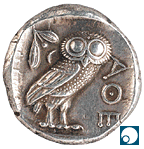

From about the eighth century B.C. and even after the Greeks were absorbed
into the kingdoms of Alexander the Great and his successors, the Greek world
was characterized by the polis, the city-state, of which there were
several hundred. Each polis consisted of a city and its surrounding
countryside, and each had its own form of government, its own patron deities
and heroes and sanctuaries dedicated to them, and its own distinctive economy.
The poleis were fiercely independent, even when they were ruled by
tyrants or dominated by Hellenistic kings, and their coins are eloquent
testimony to their autonomy. Almost from their earliest appearance Greek
coins used a combination of figures, symbols, and inscriptions to emphasize
the independence and individuality of the poleis, depicting their
patron deities and heroes, products, and even visual puns on the cities'
names.
The earliest coins appeared in western Asia Minor in the late seventh century
B.C. Whether they were invented by the Ionian Greeks or by the neighboring
Lydians will probably never be known, but it was the Greeks who spread coinage
throughout the Mediterranean, introducing it to many non-Greek peoples with
whom they came in contact. At first, Greek coins were stamped with designs,
which numismatists call "types," only on the front or obverse,
and the reverse carried the impression of the punch used to stamp the metal
into the obverse die, but by the end of the sixth century the punch also
carried a die for the reverse, and from this point onward most Greek coins
had types on both sides. Although on the earliest Greek coins, and particularly
on the early electrum issues of Asia Minor with their constantly changing
types, it is not always clear what dictated the choice of types, it soon
became almost universal practice to use types and inscriptions that identified
the polis issuing the coins.
(Continues...)



The coin depicted on this page is No. 30,
tetradrachm of Athens, c. 450-40 B.C. Reverse: Owl.
All contents copyright (c) 1996.
Lawrence University
All rights reserved.